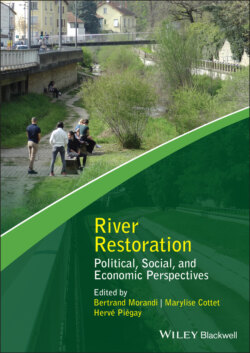Читать книгу River Restoration - Группа авторов - Страница 22
1.4.1.1 A broad public at the heart of the debate to characterize society’s support for river restoration projects
ОглавлениеThe majority of publications focus on the relationships that the “public” –“inhabitants,” “residents,” or simply “people,” or “citizens” – have with restored or to be restored rivers (e.g. Larned et al. 2006; Weber and Stewart 2009; Hong et al. 2019), notably through survey approaches (see Box 1.2). These designations generally refer to all people making up society, regardless of the relationship they may have with the river. Within this population, local people (local residents) occupy a special place insofar as they live within the confines of the river (Tunstall et al. 2000; Seidl and Stauffacher 2013; Westling et al. 2014). Proximity to the river is also a subject of discussion in the definition of “local.” From what distance is one concerned by a river restoration project? Are the expectations the same whether one lives near or far? These are questions raised by Soto‐Montes de Oca and Ramirez‐Fuentes (2019), whose objective was to evaluate the benefits of restoration perceived by inhabitants according to their proximity of residence to the Atoyac River (Mexico). This study shows that, more than the distance of residence, it is the frequency of use of the river that determines the interest in its restoration. River users, whether residents or nonresidents, are the focus of a number of scientific works (e.g. Polizzi et al. 2015; Deffner and Haase 2018; Zingraff‐Hamed 2018). Generally speaking, publications dealing with human–river relationships often consider these different categories of stakeholders as forming public opinion and participating in political life and, through their positions, guiding the modalities of public action and, therefore, restoration projects. There are many publications linking the question of the relationship to the river to political issues (e.g. Junker et al. 2007; Davenport et al. 2010; Barthélémy and Armani 2015; Fox et al. 2017). The challenge underlying these publications is to understand how, in the context of projects, the relationships that local societies have with a river can give rise to support or opposition to its restoration. They sometimes position themselves ahead of projects to determine and anticipate, among the diversity of forms of relationships with the river, those that can help to ensure the adhesion of residents to the restoration project (e.g. Buijs 2009). They can also be located after projects to assess the degree of satisfaction or dissatisfaction with the changes that projects have brought about in terms of the links that residents have established with the river, or that they have established with each other around the river (e.g. Buijs 2009; Verbrugge and van den Born 2018). In particular, Buijs (2009) has shown, through the case of the restoration of the Rhine (Netherlands), that opposition to restoration projects generally responds to questioning of the foundations of people’s attachment to the river.
